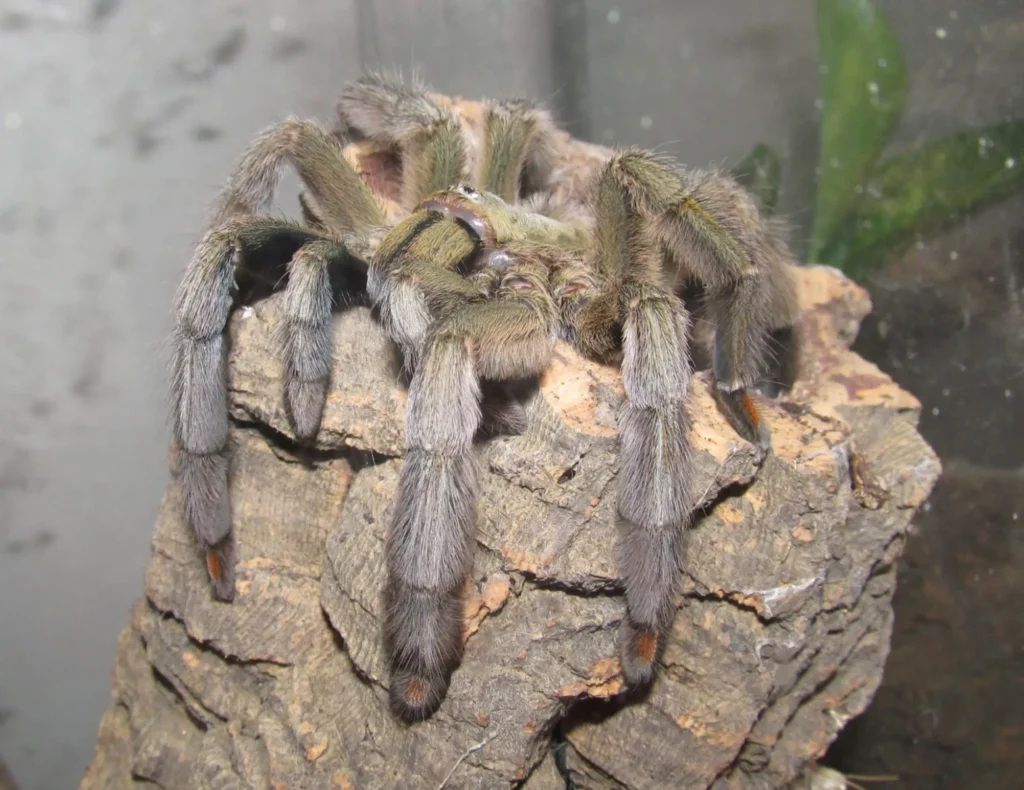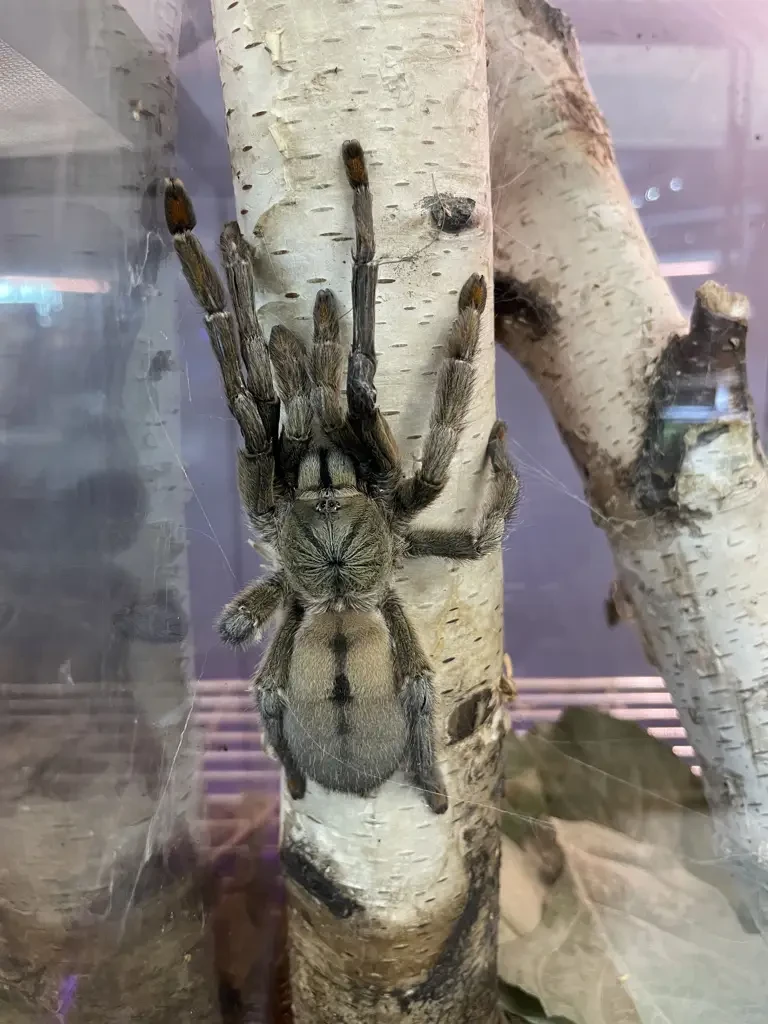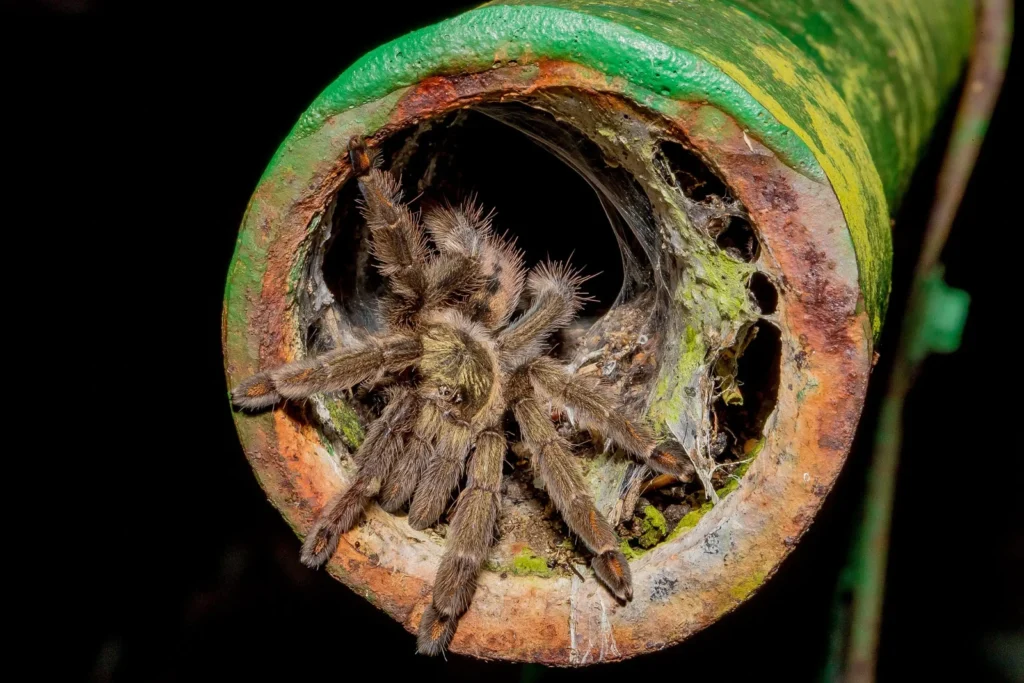Trinidad Chevron (Psalmopoeus cambridgei) is a tropical tree spider from the family of bird-eating spiders (Theraphosidae), which impresses with its beauty, speed, and unique behavioral features. It grows on the island of Trinidad and is one of the most popular species among enthusiasts involved in the cultivation of exotic spiders.
📌 What makes it special?
✔ Impressive green-brown color c with a chevron pattern
✔ Very fast and agile spider
✔ Does not weave traditional snares, but lives in shelters
✔ Venomous, but its bite is not fatal to humans
✔ One of the most beautiful bird-eating spiders in the world
Let's take a closer look at what makes this spider so special!

Scientific classification
✔ The Kingdom: Animals (Animalia)
✔ Type: Arthropods (Arthropoda)
✔ Class: Arachnids (Arachnida)
✔ Row: Pavuk (Araneae)
✔ Family: Bird-eating spiders (Theraphosidae)
✔ Gender: Psalmopoeus
✔ View: Psalmopoeus cambridgei
📌 The name "Trinidadian chevron" comes from the characteristic pattern on the spider's abdomen, which resembles the shape of a chevron (V-shaped pattern).
Appearance and dimensions
🕷 What does the Trinidad chevron look like?
✔ Body size: 5-7 cm
✔ Paw span: up to 15 cm
✔ Color:
* Young individuals have a gray-brown hue
* Adult spiders-bright green-brown color
✔ Distinctive feature: light brown stripes ("chevrons") on the abdomen
✔ Paws: long, covered with thick hairs
✔ Chelicerae: powerful, used for injecting poison
📌 Females are much larger than males and can live up to 12-15 years, while males – only 3-5 years.
Distribution area
🌍 Where does the Trinidadian chevron live?
✔ Natural area-island Trinidad (Caribbean region)
✔ It is also found in neighboring areas of South America
✔ Likes tropical rainforests, where it settles on trees
📌 This spider is arboreal, living in hollows or under the bark of trees.
Lifestyle and behavior
🌿 How does Psalmopoeus cambridgei live?
✔ Woody appearance - rarely descends to the ground
✔ Ambush Predator - quickly attacks prey
✔ Does not spin large webs - creates a web shelter in the bark of trees
✔ Active at night
📌 This spider is known for its lightning-fast speed and aggressive territory defense.

Food
🍽 What does the Trinidadian chevron eat?
✔ Insects (crickets, cockroaches, beetles)
✔ Small spiders
✔ Small lizards
✔ In rare cases-small rodents
📌 This spider not only attacks its prey with lightning speed, but also uses venom to paralyze it.
Reproduction
❤️ How does the Trinidad chevron breed?
✔ Mating season: warm season, depending on humidity
✔ Mating: the male carefully approaches the female, risking being eaten
✔ Egg cocoon: the female lays up to 150-200 eggs
✔ Spiders hatch in 4-6 weeks
✔ Juveniles grow rapidly, shedding several times a year
📌 If the male is too aggressive or approaches carelessly, the female may eat him before mating.
Poison and danger to humans
🚨 Is a Trinidadian chevron bite dangerous?
✔ A medium-strength poison - not fatal to humans
✔ Bite Symptoms:
* Severe pain
* Edema
* Muscle cramps
* Slight dizziness
📌 A Trinidadian chevron bite is not fatal, but it can cause severe pain and an allergic reaction. In most cases, the symptoms disappear after 24-48 hours.

Home maintenance
🏡 Can I keep a Trinidadian chevron at home?
✔ Yes, but only for experienced owners
✔ Terrarium:
• Height – not less than 30-40 cm (since it is a woody species)
• Temperature – 24-28°C
* Humidity – 70-80%
✔ Feeding: 1-2 times a week by insects
✔ Important: this spider is very fast and aggressive
📌 Psalmopoeus cambridgei-not for beginners, as its speed and venom can be dangerous if handled incorrectly!
Interesting facts
💡 It is one of the fastest spiders of its kind!
💡 Its venom can affect the nervous system of insects, but is not fatal to humans.
💡 Females can live for more than 10 years!
💡 Instead of traditional weaving, the net creates spider nests in tree hollows.
Conclusion
🕷 The Trinidadian Chevron is a unique Spider from the Caribbean Jungle. He attracts with his bright appearance, speed and aggressive behavior. Although its venom is not fatal, the bite can be quite painful. Due to its exotic appearance and unusual lifestyle, this spider has become popular among terrarium spider lovers.
❗ However, it is not suitable for beginners-its aggressive nature and rapid movements can pose a risk even for experienced owners!